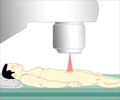A new pilot study reveals how urine biomarkers can show the amount of significant cancer in a prostate, highlighting with more certainty which men need treatment.

The most commonly used tests for prostate cancer include blood tests, a physical examination known as a digital rectal examination (DRE), an MRI scan, and an invasive biopsy.
However, doctors struggle to predict which tumors will progress to a more aggressive form, making it hard to decide on treatment for many men.
Previous studies have shown that Prostate Urine Risk (PUR) test could identify men with high and low-risk cancers but its role in deciding treatment options for men with intermediate-risk disease had been less clear.
Lead researcher Dr. Jeremy Clark, from UEA’s Norwich Medical School, said: “While prostate cancer is responsible for a large proportion of all male cancer deaths, it is more commonly a disease men die with rather than from”.
There is a desperate need for improvements in diagnosing and predicting outcomes for prostate cancer patients to minimize over-diagnosis and overtreatment.
Advertisement
The ‘risk’ here refers to the aggressiveness of cancer and its potential to spread to other organs, which would eventually kill the patient.
Advertisement
Around half of the men diagnosed with prostate cancer fall into this group and the treatment pathways for them have been less clear, until now.
It is known that disease progression in intermediate-risk men is associated with the presence of increasing amounts of Gleason pattern 4 cancer in their prostate.
This new study shows that the PUR test can assess the amount of Gleason pattern 4 without the need for a biopsy.
PUR not only measures the presence of aggressive cancer but also measures the increasing amount of aggressive cancer in a prostate.
This means that it can show us which men at intermediate risk may require treatment and which may instead be managed conservatively with surveillance.
This finding is important because men whose prostate tumor contains varying levels of Gleason Pattern 4 need a biopsy to determine whether they should receive active treatment or can be managed by active surveillance.
Further validation of this research in a larger study cohort can involve this non-invasive PUR test in the decision-making process without an invasive biopsy that is associated with discomfort and risk of infection.
Source-Medindia

![Prostate Specific Antigen [PSA] & Prostate Cancer Diagnosis Prostate Specific Antigen [PSA] & Prostate Cancer Diagnosis](https://images.medindia.net/patientinfo/120_100/prostate-specific-antigen.jpg)













